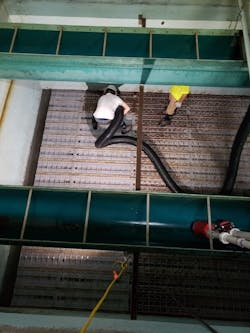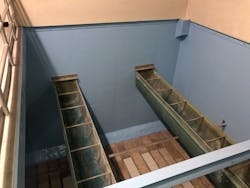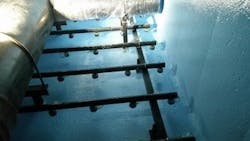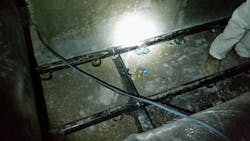Benefits of Proactive Asset Management
Scott B. Kelley is a water system consultant for Suez Advanced Solutions. Kelley can be reached at [email protected].
undefinedLocated in South Burlington, Vermont, the Champlain Water District (CWD) is a nationally recognized leader for drinking water treatment. Its exhaustive resume includes awards ranging from the American Water Works Association “Best of the Best” People’s Choice Water Taste Test to recognition as the first water supplier in the nation to receive the “Excellence in Water Treatment Award” for completion of all four phases of the Partnership for Safe Water Program.
Contributing to its success is the commitment of its board of water commissioners and staff to maintain a proactive approach to management of the district’s facilities, process and infrastructure.
CWD operates as a wholesale water supplier of water to 12 municipal water systems, which are located in eight communities covering approximately 70 square miles in northwestern Vermont. These systems account for approximately 24,000 connections with 75,000 customers. While it also has a retail division providing contract operation services to a select number of its served systems, CWD’s primary function is producing water and transmitting it to the 12 communities.
The district’s water treatment plant, which has been online since 1973, is approved for 20 million gallons per day and gets source water from Shelburne Bay in Lake Champlain. The lake water is treated through three adsorption clarifiers that remove much of the bulk material. Polishing and finish treatment are done through eight deep bed multimedia filters. The water is then disinfected and pumped out to the district’s customers.
Exploring Asset Management
In recent years, asset management has become a cornerstone of Champlain’s approach to proactive management of key assets in its treatment and distribution system. It first implemented an asset management program a few years ago to keep its 15 tanks in top condition.
“When we came online in 1973, we were in a growth mode. We wanted to ensure that we could provide the water that was needed, as the communities that we served were growing and expanding,” said Joe Duncan, general manager of CWD, who is responsible for overseeing operations. “Then in the early 2000s, our mindset changed, shifting our concentration from a growth mode to a sustainable mode. In doing that, we took a close look at the condition of our water tanks and realized that they had not been getting as much care as we were looking for. We looked at what it takes to maintain tanks from coatings to a safety and security standpoint. We realized that in order to provide the level of service we were aiming for major capital outlays would be required.”
The district first looked at finding a way to manage these assets in-house. However, after looking at the projected capital costs and their staffing levels, it became apparent that committing the resources required to care for the 15 tanks in the system posed a daunting challenge.
Another element that the district wanted in a maintenance program was having a single-source responsibility for the condition and reliability of its assets.
“For example, the ability to have someone who inherits the risk associated with coatings and the equipment that is installed on the tanks was a big factor,” Duncan said. “In traditional models where there are multiple parties involved — such as engineers, the coatings manufacturer, contractors and an inspection firm — there’s always the question of who takes responsibility if and when something goes wrong.”
CWD found its answer in the water tank asset management program provided by Suez, a turn-key solution that keeps all critical water assets in good operating condition and fully compliant with all applicable regulations, minimizing maintenance and renovation costs.
This program restores tanks to their like-new condition then takes full responsibility of water tank maintenance for the long term. Each water tank management contract is designed and executed based on the specific requirements of the customer and condition of the asset. Suez’ program provides a single point of contact for all service needs.
From Tanks to Filter & Clarifier Maintenance
The success of the tank asset management program encouraged the district to explore other parts of its system where it could apply that model, in particular, their filters and clarifiers in their water treatment plant.
“We have three adsorption clarifiers and eight filters that are part of our treatment process,” Duncan said. “Historically, we maintained these filters on our own with a local contractor, but it was a natural progression to take a look at Suez based on the experience we had with our tanks and the relationship we had established.”
Internal conversation centered around applying fundamentals with tank management to the filters and clarifiers. By adopting known and understood processes, execution would be easier to guarantee, providing better filter and clarifier health.
“Having our filters and clarifiers in a maintenance program and being able to have one entity that knows them and how to service them and knowing we can call them if there is an issue is great,” said Duncan. “Perhaps we identify something that’s come up, such as painting needs on the filters, media handling needs in the filters, or access issues with the clarifiers and we want to address adding hatches and how to do that.”
This program does not require him or his team to handle media extraction and replacement nor does CWD need to hire contractors for painting and coating or for cutting and installing hatches.
“We just need to call Suez and say, ‘These are the things that we’re facing and we’re looking at’. If we have an issue, they are right there to work with us on it, and if it’s something that is related to work that they did, they’ve stepped up and owned it and addressed it,” Duncan said. “And if it’s not, we identify that it’s not, and we work together to get there, and if it’s outside the defined scope of work, we work together and come up with a plan to address that.”
The Filter & Clarifier Maintenance Program
The goal of the filter and clarifier maintenance program is to restore the filtration system to “like new” conditions and improve the return on these large capital investments while lowering related long-term operation and maintenance costs. The program entails:
- Assessment including backwash observation, bed expansion, media height and depth;
- Filter renovation and filter coating with 100% solid epoxy;
- Filter media is removed and replaced or topped-off, and underdrains are replaced;
- Chemical cleaning of filter walls above the media. Suez uses proven, NSF-certified technologies for chemically cleaning the interiors of granular filtration systems; and
- Clarifier renovation, including applying and maintaining coating systems, removing, washing, and replacing clarifier media, inspecting and documenting clarifier components, and identifying any deficiencies.
Moreover, if upon laboratory evaluation, the buildup of inorganic deposits and/or biofilm in the filter is too severe for chemical cleaning to be cost-effective, or if existing media is too worn or degraded, NSF-certified materials that match the current system specifications will be installed.
The program uses AWWA-approved methods to replace all types of granular media, support gravel, garnet (high-density) sand, silica sand, and anthracite, disposing old materials responsibly.
Benefits of the filter maintenance program include increased filter capacity and extended media life, improved bed porosity, reduced particle cohesion and reduction of effects of biofilm and inorganic deposits. The program also maintains regulatory compliance.
Quantitative & Qualitative Benefits
Duncan notes that cost savings, predictability and compliance are immediate benefits of this program.
“From a cost perspective, versus what we were paying with the previous contractor, as well as bringing in multiple contractors, we’ve seen a great cost savings,” Duncan said. “The other thing that is a real benefit to us is being able to spread those costs over a 10-year payment period. Having the base services in a fixed payment each year is very valuable to us because it sets the expectation for our budget, it’s an item that we know we need to carry, it’s a line item that we know what the number is.”
In a similar way to maintaining tanks individually, maintaining filters in the same way created some variance in costs year over year. Duncan said this could make it challenging to budget for the maintenance.
“Now each year, we have a meeting before we put our budget together; we know what the base cost is, but then we talk about accessories, those things that aren’t necessarily in the scope of services,” Duncan said. “We get prices from SUEZ, and we work them into our budget. That cost control is very valuable to us.”
Left: Completed preparation for the installation of new filter underdrains. Right: Preparing for the installation of new filter underdrains.
Another benefit observed was the impact on water quality.
“As for water quality, we put out a consistent product. Of course, you are trying to improve your water quality through these filters, and by improving the maintenance efforts, enhancing and being more proactive and preventive with it, it’s improving the level of service from that asset,” he said. “I can say that after we redid the filters, when we looked at length in between back washes and the turbidity coming out of the filters, we noticed significant performance improvement in some of the filters.”
As to Champlain Water District’s experience with asset management and maintenance programs, Duncan recommended the model for utility consideration.
“The volatility of the market and the ability to know that something is going to be serviced is challenging,” he said, “and putting aside money for future repairs doesn’t always work as the money that’s been put away might be diverted to other needs. So, I believe this model has extreme value, because you know that once you’re in the program, maintenance and repairs will move forward.”



